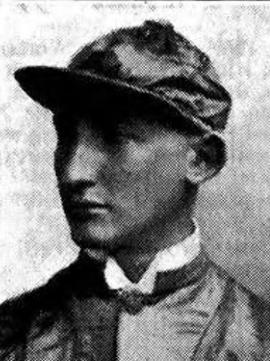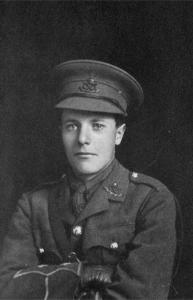Cragg-Hamilton, Derek, son of Sydney Charles Cragg-Hamilton and Edith, d. of Abel Simner of Friog, Merioneth; b. 3 Apr. 1909; adm. Sept. 1922 (A); left July 1927; adm. a solicitor Nov. 1932, practised in London; 2nd Lieut. 92 Bde RA (TA) Sept. 1927, Lieut. Sept. 1930, Capt. May 1934, temp. Maj. Jan. 1939; killed in action Dunkirk May 1940.
Derek Cragg-Hamilton was born at Ravenscourt Park, London on the 3rd of April 1909 the only son of Sydney Charles Cragg-Hamilton, an actor, and Edith Emily Marguerite (nee Simner) Cragg-Hamilton of 77, Hamlet Gardens, South Hammersmith, later of Newark-on-Trent in Nottinghamshire. He was christened at St Peter’s Church, Hammersmith on the 12th of June 1909. He was educated at Westminster School where he was up Ashburnham from September 1922 to July 1927 where he was a member of the Officer Training Corps and was promoted to Lance Corporal in 1926. He was appointed as a Monitor in April 1926 and as Head of Ashburnham in September 1926. On leaving school he studied law and he qualified as a solicitor in November 1932. He practised at Temple Chambers, Temple Avenue, London. He served as Hon. Secretary of The Old Westminster Boat Club in 1929 and 1930 and was a member of the Executive Committee of the Old Westminsters in 1932.
He was commissioned as a 2nd Lieutenant in 92 (5th London) Field Brigade in the Territorial Army on the 25th of September 1927 and was promoted to Lieutenant on the 25th of September 1930. He was promoted to Captain on the 10th of May 1934 and to Major in January 1939. He was appointed as the commanding officer of 365 Battery.
On the 31st of May 1940, 92 Field Regiment, Royal Artillery was positioned to the west of Bulskamp where it was defending the perimeter of the evacuation area around Dunkirk when German counter battery fire began falling on the Headquarters of 365 Battery. Derek Cragg-Hamilton and four gunners were killed during the exchange of fire.
The Middlesex Chronicle wrote: - “Many of the older residents will remember the cherry, happy personality of this fine, upstanding soldier who was 6ft 6 1/2 ins. in height.”
The Elizabethan wrote: - “The death of Major Derek Cragg-Hamilton, R.A., T.A., during the retirement to Dunkirk, has brought sadness to many, for he had many friends. In the law, which he chose as his profession, in the Territorials, which he joined as a recreation and a duty, and among Westminsters of all ages who shared with him a common affection for the School he was equally popular, and the directness and simplicity of his character won him general respect. Derek Cragg-Hamilton was the son of the late Sydney Charles Cragg-Hamilton. He was born on 3rd April, 1909, and in 1922 entered Westminster as a day boy up Ashburnham. Although his subsequent career showed that he had good critical abilities and the power of mastering detail, he travelled up the School but slowly. He was never one to whom success came easily. Success came because he worked for it, and it was a tribute to the solid qualities of his character when, in his last year at Westminster, he was appointed head of his house, although still only in the Shell. He left in 1927, and for the next five years underwent the arduous and sometimes dreary training necessary to become a solicitor. Most of his Westminster friends and contemporaries had gone to either Oxford or Cambridge, and he may perhaps have felt some natural regret that he was no longer with them, sharing their fresh interests and pleasures. If he did, he kept his feelings to himself and he threw himself wholeheartedly into his new work. At this time also began the connexion with the Territorials, which in the end took him to France early last September and last May to Belgium. He was gazetted 2nd Lieut., 92nd Brigade, R.A., T.A., in 1927, and was promoted Lieutenant in 1930. Captain in 1934, and Major last year. He was an enthusiastic soldier, and he was always keen to get any boys who had recently left the School into his battery, with the result that the foundress was toasted last November 17th in at least one mess in northern France. His ability as a lawyer received a tribute in a notice in The Times, and this is not the place to recapitulate it. While his Westminster friends realized that he was efficient at his job, they did not perhaps realize how much his judgment was respected and how much he might have achieved had not his career been suddenly cut short. But no one who came in contact with him could have remained unaware for long of his enthusiasm for the School and his devotion to its interests. His work on the War Memorial Committee and on successive Committees of the Westminster Ball brought him into touch with a very large number of Old Westminsters; and because some of the masters were privileged to count him as their friend, his views on the School did not remain static as the point which they had reached when he ceased to be a member of it, but moved forward with every phase of its development. He was, indeed, one of the very few people to whom one could "talk Westminster" with the complete assurance that his opinion would be based not only on sympathy and understanding, but also on knowledge of where the School's true interests lay. To Watermen of the last twelve years he was a familiar figure. Although never a first-class oar himself, he was an immensely hard worker in a boat and a good judge of a crew. He followed the fortunes of the School eight with keenness, and his appearances at Putney or at Henley were welcomed with delight. It was characteristic of him that when, a few years ago, he had followed a School eight down to Westminster in the launch and a minor crisis had occurred because one of the crew had been taken ill, he should have stepped into the boat and, although quite untrained, should have rowed back to Putney. It was characteristic, too, that when home on leave for a short time last December, one of his first actions should have been to come round to Westminster to find out how the School was getting on in exile, and in particular what chances there were of carrying on rowing at Lancing. In him Westminster loses a loyal friend, and his mother, to whom we offer our deep sympathy, a devoted son.”
He is buried at Veurne Communal Cemetery Extension Row C, Grave 5.

